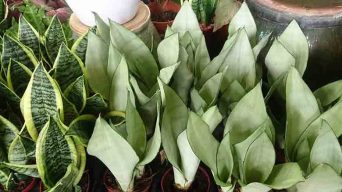The Orchid cactus is one of the most beautiful plants a home gardener can grow.
The colors and textures it produces are a welcome addition to almost any décor, and no matter how hard you try, you’ll never get tired of the subtle fragrance that emanates from this plant.
Orchid cactus care is very easy, as this plant is almost indestructible. It provides beautiful flowers and can also be propagated with ease.
In this article, we will provide a complete guide on how to take care of Orchid cactus plants and how to propagate them.
Orchid Cactus Care Overview
The Disocactus ackermannii (formerly classified as Epiphyllum ackermannii), commonly known as the Orchid cactus, is a flowering plant from the Cactaceae family native to Mexico.
The Orchid cactus is an epiphytic plant with a short cylindrical main stem and longer leaf-like portions with wavy edges.
The Orchid Cactus has a short, rounded base and longer flattened leaf-like portions that range in length from 10-75 cm (4-30 in) and width of 5-7 cm (2-3 in).
The plant grows out of the base and arches down, measuring 1 m (3 ft) in length.
The flowers are crimson to scarlet and funnel-shaped, with greenish throats. They may grow to be 5.6 inches (14 cm) in diameter.
The blooming process begins in the middle of spring, and once open, flowers will remain open 24 hours a day, seven days a week.
How To Care for Orchid Cactus Plants
Orchid cactus care is not difficult, but it requires a little know-how.
Whether you’re a new grower or have been growing cacti for years, here’s everything you need to know about how to care for Orchid cactus.
Sun Exposure & Light Requirements
Orchid Cactus plants do best with bright but indirect sunlight; morning or late afternoon sun is perfect. Orchid Cacti do best with at least six hours of indirect sunlight.
Avoid direct sunlight as much as possible, as the bright light will burn your plant.
If you are placing them indoors, choose a window that gets lots of light without direct sunlight for at least six hours.
You can leave your orchid cactus outside during spring and summer; however, keep it in partial shade if it is placed in an area of full sun.
Orchid cacti can be placed outdoors year-round, but they will need protection from the sun during the hottest parts of summer.
They will be fine in a sheltered spot – such as a patio – or even on a wall. But do not put them in an open position where they will get direct sunlight,
Watering Requirements
The Orchid cactus likes to be watered about once or twice a week.
Water must fall directly onto the soil, ensuring that the roots can properly intake the water.
The best time to water your orchid cactus plant is in the morning or late afternoon.
It is advisable not ever to let the orchid cactus dry out. Once the soil is dry to the touch, it will be time to give your plant some water.
This ensures that you do not overwater your plant. If you overwater your plant, the roots will start rotting and eventually kill the plant.
If the leaves on your orchid cactus start curling up or turning brown and crispy, it is a clear sign that you need to water it more often.
Soil Requirements
Orchid cactus requires a soil mix that is well-draining, well-aerated, and loose.
A cactus mix is ideal. In most outside gardens, cactus soil is available in the landscape center, or you can make your own with a mixture of potting soil (without fertilizer), coarse sand, and perlite.
The coarseness of the sand ensures that water will drain out. The perlite aerates the soil by allowing air to reach the plant’s roots.
A one-to-one ratio is used because it balances drainage with good soil aeration.
Cactus plants can also grow in a potting soil mixture containing organic material, but perlite is needed to lighten the soil and ensure good drainage.
Temperature and Humidity
The Orchid cactus is a subtropical plant.
So in place of having it with dusty dry air, the most appropriate atmosphere for the Orchid cactus would be moderate humidity, yet not too cold or hot when the temperature is around 55~75 F (12~24 C).
Extremely high temperatures or extremely low temperatures are counterproductive for growing Orchid cacti.
The Orchid cactus can not stand frost and should be kept in a cool place like an ordinary house.
For every night temperature, keeping it at 55~65 F (12~18 C) is recommended.
Fertilizing
An Orchid cactus has an extensive root system and requires lots of nutrients. The success of growing an Orchid Cactus depends on proper fertilization.
A balanced liquid fertilizer diluted to half-strength can be applied every two weeks during the spring and summer months, but it is essential to be careful not to over-fertilize.
However, if your cactus produces many blooms during this period, you can increase the frequency of fertilizing, but you should still only apply the fertilizer at half the recommended strength.
When applying fertilizer, it is important to water your Orchid cactus thoroughly before and after fertilizing to flush out any excess salt build-up that would otherwise accumulate in the soil.
Potting and Repotting
The Orchid cactus requires repotting yearly, as its root system grows large.
The best time to repot the Orchid cactus is during the growing season after flowering has finished for the year.
The pot should be 2 inches larger than its current size, with deep pots being better than shallow ones. Make sure the pot has a drainage hole in the bottom.
If you have a young or small Orchid cactus plant, it may only need to be repotted once every two years.
If your plant is already very large, it will need to be repotted more often. Repotting an older Orchid cactus should not be delayed, as it can cause root rot, which is very difficult to treat.
When it’s time to repot the Orchid cactus, carefully remove the old soil from around the roots, not damaging any of them.
Place the Orchid cactus in its new pot, spread the roots out into a fan shape, and fill it with fresh soil.
Don’t water the Orchid cactus right away after repotting. Watering too much can cause root rot, so wait until the soil is completely dry, then water sparingly for several weeks.
The Orchid cactus will need to be fertilized after being repotted.
Pruning
Orchid cactus should be pruned as needed to keep them looking healthy and full.
Generally, pruning is only needed if a stem is damaged or begins to rot.
If you would like to encourage new growth on vines that have stopped producing new leaves, they can be pruned back.
Pinching off the growing tips of cacti will increase branching and produce more flowers.
Pruning also encourages new growth on long vines, although these vines tend to grow faster and thicker than shorter vines.
Pruning should be done in the spring and summer when the plant is actively growing. This allows for faster healing and regrowth.
Only use sterile tools to prune to avoid transferring disease from one part of your cactus to another. Also, clean tools ensure that there is less chance of the plant getting an infection in its cut.
Plants should only be pruned after flowering to avoid disturbing the flowers or their natural growth cycle.
Pests and Diseases
Orchid cactus care starts with good planting conditions. They are very susceptible to pests and diseases.
The most common culprits are spider mites, mealybugs, aphids, scale insects, thrips, and fungal infections.
Mealybugs
Mealybugs are small, soft-bodied insects that suck plant juices.
They cluster together in colonies on the underside of the leaves and stems. Mealybugs excrete a white waxy coating that looks like cotton.
Mealybugs can be controlled by using insecticidal soap or neem oil.
Aphids
Aphids come in many colors and shapes. They are small, soft-bodied insects that cluster together on the leaves and stems of your plant.
Aphids can be controlled by using insecticidal soap or neem oil.
For really bad infestations, use a spray bottle to wash off aphids with water and soap.
Scale Insects
Scale insects are small, oval, brown, or black insects that form a hard protective shell on their bodies.
They cling to the underside of leaves and stems and can be challenging to see with the naked eye.
Scale infestation can be prevented by planting your orchid cactus in well-drained soil.
If you notice infestations, treat them with insecticidal soap or neem oil once a week for two weeks.
Thrips
Thrips are tiny insects that appear white, yellow, pink, or black.
They suck the juices from the leaves and stems of your plant.
Thrips can be controlled by using insecticidal soap or neem oil. For terrible infestations, use a spray bottle to wash off thrips with a mixture of water and soap.
Fungal Infections
Fungi cause the most common type of leaf spot in succulents. Leaf spot diseases are usually due to excessive moisture.
Good air circulation will help to reduce the risk of bacteria or fungi affecting your plant.
If you notice any fungus on your leaves, treat it with fungicidal soap or neem oil.
How to Care for Orchid Cactus in Winter
Orchid Cactus care during wintertime is relatively easy. This succulent plant doesn’t appreciate cold drafts and requires bright light.
To continue growing during wintertime, keep it in a bright location and make sure the temperature stays above 10°C (50°F) at all times.
When the temperature starts dropping during the winter, take your plant inside.
The Orchid cactus doesn’t require much water during winter, but check the soil before watering and don’t let it dry out completely.
If the weather is sunny, ensure you water it every few weeks, but if wintertime brings along cloudy days with little sunlight for your plant to absorb, you can wait up to 4-5 weeks without water.
The bottom leaves are likely to drop if the plant doesn’t get enough water. If this happens, don’t worry because the plant will grow new leaves when spring arrives.
It can take several weeks for your plant to resume growing after it has gone through the winter dormancy period.
How To Propagate Orchid Cactus Plants
The Orchid Cactus can be propagated from seeds or cuttings.
Propagating from seeds is the easiest way. Propagation of the cactus plant through cuttings is slightly more complex but results in a higher success rate.
Growing Orchid Cactus From Seeds
To propagate the Orchid Cactus from seeds:
- Soak the seeds in hot water for 24 hours.
- Plant the seeds on top of moist soil.
- Cover with a thin layer of sand to retain moisture while germinating.
- Put the pot where it receives filtered light and avoid direct sunlight initially, which can cause cacti seedlings to dry out.
- Water the soil when it becomes dry; to test whether or not the soil is too dry, touch the top of the soil; if no water comes out, it needs watering.
- The seedlings will start growing between 1-3 months after planting, depending on how much sunlight they receive.
- Once they are 1-2″ tall, transplant them into new pots.
Propagating Orchid Cactus Through Cuttings
To propagate through cuttings:
- Cut off a section of one of the cactus’ arms using clean, sharp shears.
- Let the cutting dry out overnight to let the cut seal naturally. The cut must be below a node on the cactus for rooting to occur.
- Place the cuttings on moist soil and cover them with sand to retain moisture while rooting.
- Put the pot where it receives filtered light and avoid direct sunlight initially, which can cause cacti seedlings to dry out.
- Keep the soil moist by watering the seedling every 1-2 days until it starts growing roots.
- Once the cactus starts growing new roots, remove it from its pot and plant it in a container with cactus potting mix.
- Place the pot in filtered light or indirect sunlight.
- Water frequently initially but reduce to moderate watering after roots have formed.
Final Thoughts
Growing Orchid cactus is not hard to do. It’s a beautiful plant that can live for many years if cared for properly.
If you follow the basics of Orchid cacti care, you’ll find that they’re not difficult to maintain.
Just be sure that you’re ready for a relatively long growing period.
The Orchid cactus can take a while to bloom, but I’ll leave it up to you whether or not the process is worth the wait.







